This post is comprised of different sections
Take a look at our review of Cloud Atlas!
Learn more about Buddhism and Nietzsche’s Eternal Recurrence idea! Or check out the full explanation Cloud Atlas Explained!
This post is comprised of different sections
Take a look at our review of Cloud Atlas!
Learn more about Buddhism and Nietzsche’s Eternal Recurrence idea! Or check out the full explanation Cloud Atlas Explained!
Author: David Mitchell
Publisher: Random House
Year: 2004
Language: English
Country: UK
Number of pages: 544

Our rating
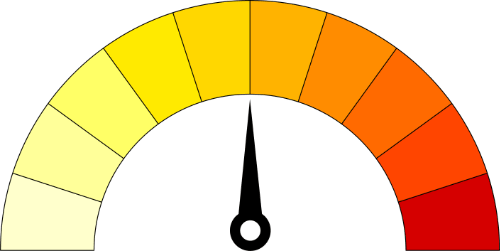
Your rating
If there was a book that taught me that first impressions can be deceiving, that would have to be Cloud Atlas.
As I began reading the first chapter, I was so utterly confused and bored that I considered giving up… As I kept reading however, I became completely absorbed!
I literally went from one extreme to the other!
Not being accustomed to the particular writing style of what looked like a book written in the middle ages, I have to admit I struggled at the beginning. However, after persevering the first few pages, the book took me through all sorts of genre: there was history, science fiction, thriller, drama, comedy – you name it!
The truth is… I couldn’t stop reading it!
Cloud Atlas feels almost like an anthology. The book is divided into 6 different but loosely inter-connected stories happening at different periods of time.
In “The Pacific Journal of Adam Ewing”, Adam Ewing is an American notary holding white-supremacy beliefs, who is traveling on board of the ship “The Prophetess” on a journey from Hawaii en route to California. Ewing’s doctor, Dr. Goose, informs him that he is suffering from a viral infection, and begins treatment immediately. At some point, Ewing finds that a slave from the Morori tribe had stowed away in Ewing’s quarters and the two begin a friendship.
The second story, “Letters from Zedelghem” happens around the 1930’s. Robert Frobisher is a bisexual musician who had been disinherited by his father. To re-gain his reputation he looks for a job as an amanuensis for renowned composer Vyvyan Ayrs, who, due to syphilis, cannot transcribe music anymore. Ayrs is convinced of Frobisher’s talent and decides to hire him, even though Frobisher dislikes Ayrs’ disagreable nature. One day, Frobisher finds one half of Ewing’s diary in Ayrs library and becomes intrigued by Ewing’s story. He also writes about his thoughts and experiences to his friend and lover Rufus Sixsmith.
The third story, “Half-Lives: The First Luisa Rey Mystery”, takes place in 1975. Luisa Rey is a tenacious journalist who meets an older Rufus Sixsmith (Frobisher’s lover in the previous story) in a lift. Sixsmith is in possession of secret and dangerous information regarding a local nuclear plant and decides to share it with Rey, setting off a series of dangerous events that threaten Rey’s life.
“The Ghastly Ordeal of Timothy Cavendish” happens a few years later after Rey’s story. Timothy Cavendish is a retired British publisher who becomes embroiled in a money dispute with gangsters related to his latest client. Cavendish seeks help from his brother, who fools him into checking in to a retirement home. A desperate Cavendish tries his best to escape the suffocating situation.
The fifth story, “An Orison for Sonmi~451”, is set in Korea, in an undisclosed far future. Enslaved clones work in humiliating conditions in a fast-food restaurant. One of these clones, Sonmi~451, is saved by a group of anti-government rebels, who show her the true reality of life for the clones.
The sixth story, “Sloosha’s Crossin’ an’ Evrythin’ After”, takes place way far into the future. Old man Zachry tells the story of an apocalyptic event that decimated most of the Earth’s population. Some humans, the Prescients, survived and use advanced technology to study a group of people in an island, which Zachry and his family live in. One of the Prescients, Meronym, travels to the island and asks Zachry to help her find the top of a volcano.
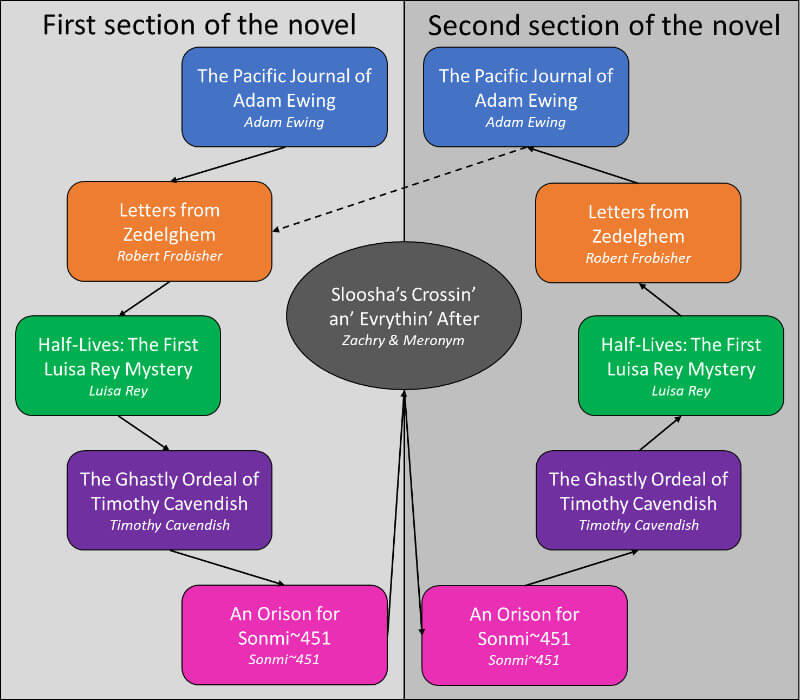
The organisation of the book is very interesting. It starts chronologically, with each chapter presenting one half of the narrative (from Ewing’s to Sonmi~451’s story). The middle story narrating the adventures of Zachry and Meronym is told in its entirety. The second part of the remaining stories are then told in reverse chronological order (i.e., starting with Sonmi~451 and ending with Ewing; see figure above).
Thus, “Sloosha’s Crossin’ an’ Evrythin’ After” functions as a mirror, connecting the two halves of each seemingly independent story.
For a book of about 544 pages, it almost reads like a novella. Each story develops at the just the right pace. Particularly interesting was Mitchell’s decision to incorporate such diverse genres for the narratives – there is action (e.g., Sonmi), drama (e.g., Frobisher) and thriller (e.g., Rey) to keep you engaged from beginning to end. It surely must require a shedload of talent as a writer to excel in pretty much every genre.
In fact, my initial apprehension regarding Ewing’s chapter is likely a consequence of the authenticity to which Mitchell depicted that particular era. Mitchell seemed to have researched the writing style of 19th century journals, and made extensive use of archaic words (e.g., betwixt) and spelling (e.g., trowzers). I should also mention that “Sloosha’s Crossin’ an’ Evrythin’ After” is a rather difficult read, mostly due to the usage of a kind of pidgin English, which takes a bit of time to get into.
The main characters have captivating personalities and are identifiable, but none of them could be considered the paragon of virtue. And that’s a good thing. You see, there is an interesting and natural progression towards self-discovery and personal growth in each and every character; this is, in fact, one of the main themes of the book, as I explain below.
The inexplicable birthmark shared by some of the characters at different epochs adds to a type of weirdness that is intriguing and involving, rather than confusing and spooky.
As you read the different chapters you’ll notice that you are reading completely different and independent stories. Curiously though, they will all feel strangely connected. Mitchell was careful not to overdo this point, with characters only making brief and casual comments about an earlier character (e.g., Frobisher reading Ewing’s diary; Rey listening to Frobisher’s musical composition; Cavendish coming across Rey’s novel; Sonmi watching a movie about Cavendish’s life; Zachry’s reverence for Sonmi).
The ending of each story is unpredictable and will not disappoint.
All in all, this is an excellent book. It takes a little bit of patience to get used to the writing style, but if you persevere, you’ll be rewarded with an absolutely fascinating story.
My only advice to you is: read the book before you watch the film. Even if this recommendation arrives too late, try to read the book as well, as it is a completely different experience.
That isn’t to say that the film is not worth it. However, in my opinion, the novel really brings out a much more intimate connection with each character, which you will need, to fully appreciate the inherent but subtle bizzareness in the novel.
To me, Cloud Atlas is one of the best books I have ever read, and for that reason it gets a star rating of 5.
The book is definitely on the weird spectrum. Remarkably, each individual story isn’t weird at all. So where is the weirdness coming from?
I believe the knowledge that some of characters are somehow intrinsically connected (via the birthmark), changes our perception of the story at a global level. That is, each story cannot be considered independent anymore; all stories are seemingly connected via a mysterious link invisible to the eyes of every character.
With such a subtle link, it’s rather astonishing that it has the capacity to evoke an actual sense of weirdness.
Cloud Atlas gets a bizarrometer score of 2.5.
The birthmark, the birthmark, the birthmark…
Surely, this is all you can think about. Why do some of the characters share the birthmark in the shape of a comet? Can it be coincidence? What is the meaning of it?
Unusual to many authors, Mitchel actually provided a hint during one interview for BBC Radio 4’s Bookclub. Here it is:
“Literally all of the characters, except one, are reincarnations of the same soul in different bodies throughout the novel identified by a birthmark […] I guess that’s just a symbol really of the universality of human nature. The title “Cloud Atlas” itself, the cloud refers to the ever changing manifestations of the Atlas, which is the fixed human nature which is always thus and ever shall be. So the book’s theme is predacity, the way individuals prey on individuals, groups on groups, nations on nations, tribes on tribes. So I just take this theme and in a sense reincarnate that theme in a different context.”
Interestingly, Mitchel has expressed his disbelief in reincarnation:
“Reincarnation is a beautiful and elegant theory and I wish I could believe in it… But, alas, I can’t, no…”
However, in an interview for Chatelaine he added:
“[there is] solace in the notion we can have another go and try and fix things and make a better job. Reincarnation is a useful idea. […] Even in one life we metaphorically die and are reborn a number of times. […] The first time you’re unceremoniously dumped is a kind of death. And you come back from it. Marriage — one former way of life has to die to make the marriage work.”
So, which of the characters are the reincarnations?
As we will describe in greater detail below, Frobisher, Rey, Sonmi~451 and Meronym all possess the birthmark. Nowhere in the book is specified that Ewing has a birthmark, but it is implied he does, given that Rey experiences an inexplicable connection with the ship Ewing was sailing on (e.g., her birthmark “throbs”).
Cavendish and Rey were both alive at some time point. Rey has a birthmark and seems connected to Ewing, so Cavendish may or may not be a reincarnation. It will depend on whether you’re willing to believe that Frobisher’s death resulted in his soul being split into two and inhabit both Rey and Cavendish during the same epoch.
Zachry is perhaps the most crucial character in the entire novel. Having the features of an unreliable narrator, it is possible that everything he’s telling is fictional: Ewing is a character in the journal-turned-book Frobisher is reading; Frobisher is a character in Rey’s letters; Rey is a character from a novel read by Cavendish; Cavendish is a character from a movie watched by Sonmi; Sonmi is a fictional goddess venerated by Zachry.
Can it all be that simple though? I don’t think so. In my opinion, Cloud Atlas is about literal reincarnation, and the idea that every human being is deeply connected both to past and future incarnates.
Borrowing Nietzsche’s idea of Eternal Recurrence (i.e., that our lives will be lived an infinite amount of times), each character is influenced by both preceding and succeeding incarnates’ behaviour with every recurrence.
Ultimately, the message of the book could be all about becoming better individuals and, perhaps, even leave an important mark on their own timelines.
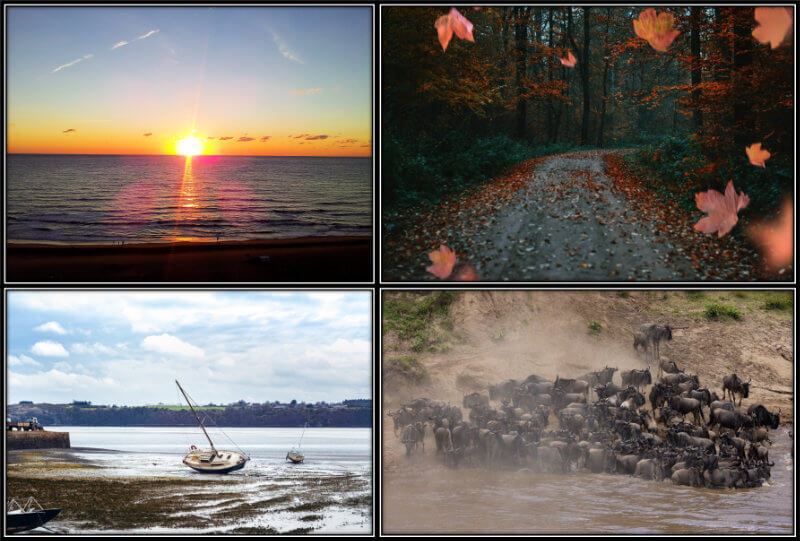
Reincarnation is the idea that when we die, something living inside of us carries on living in another body. Whether that something is an ethereal soul, a consciousness, or a memory, largely depends on what school of thought or religion you lean towards.
The belief in reincarnation (also known as rebirth, transmigration or metempsychosis) likely arose from the observation that everything in the natural world is cyclical. Phenomena such as the sunrise/sunset, the yearly seasons, tides, the growth and fall of tree leaves all obey to a cyclical pattern that repeats without fail.
So, our ancestors eventually looked at these cyclical patterns and wondered if human life might be just as cyclical. As societies formed, the belief in reincarnation took different shapes depending on geography, culture, and current knowledge.
Below, I’ll briefly explain how reincarnation, or more precisely, rebirth, is understood under one fascinating religion: Buddhism.
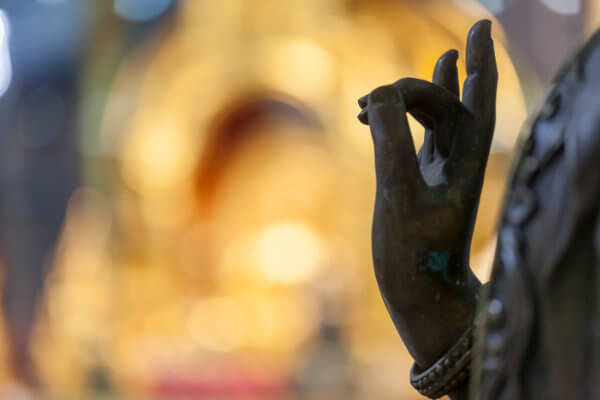
Rebirth forms a central tenet in the Buddhist religion. At the time of death, our sense consciousness (what enables us to see, hear, smell, taste, feel and think) gradually dissolves into a subtler, mental consciousness, eventually splitting from the body after we take our last breath.
This subtle mental consciousness is what Buddhists usually mean when they speak of the mind being transferred to another body. In fact, Buddhists prefer the term mindstream (as opposed to mind), to emphasise that it is our subtle mental consciousness that is eternal, and what gets passed on to other bodies after death.
The mindstream can take over a new body shortly after death, or it can remain in an intermediate stage that can last up to 49 days. In either case, the mindstream will eventually attach itself to a new body.
Once the mindstream inhabits a new body, the sense consciousness will start to develop, allowing the person (or animal) to see, hear, taste, etc. In this sense, it is the mindstream that powers life.
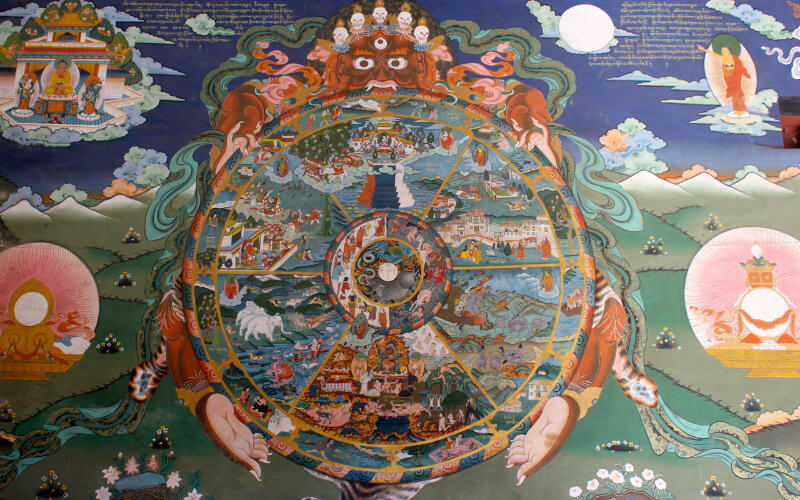
Only sentient beings that are capable of consciousness can be reborn, and they will do so in one of six different realms.
If rebirth takes place in the three lower realms – hell, hungry ghosts and animals – the new life will mostly be one of suffering. In contrast, rebirth in one of three “higher” realms – humans, demi-gods or gods – the new life will be more pleasant and favourable.
This process of dying and rebirth in one of the six realms is cyclical and eternal (also called samsāra), unless one attains liberation (aka, nirvana; more on that below). Thus, our mind might be reborn in the animal realm at one time, but in the next life we might be reborn as a human (or vice versa).
This begs the question: what determines in which realm an individual is going to be born in?
The answer is straightfoward: karma!

In short, karma means actions, as in:
– physical actions (e.g., doing exercise, playing the lottery, hugging your friend, stealing, etc)
– verbal actions (e.g., verbal abuse, love proposal)
– mental actions (e.g., feeling envious, having remorse, wishing someone well).
It turns out that every action we do in our lives leaves a trace, or imprint, on our mindstream. Thus, our mindstream is the place that accumulates imprints during our lifetime.
Because the mindstream is dependent upon our past behaviour (i.e., on our actions, or karma), it is never static, but always changing. This is why Buddhists don’t adhere to the idea of a fixed soul.
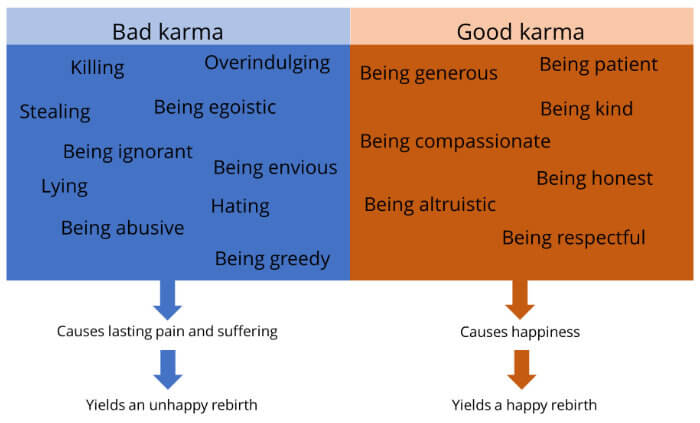
In Buddhism, you cannot choose which actions are imprinted in your mindstream. Every action you do will leave a trace on your mindstream. Nevertheless, not every action will weigh the same when deciding in which realm you will be born into.
It is, therefore, to your own advantage to act virtuously and good, since you will be rewarded with a happy rebirth. Act non-virtuously and your next life will be less generous.
Suppose, you aren’t a clingy person, not too attached to material possessions. You might not even have much money, but you are always keen on helping others with whatever little means you have. Such actions would be imprinted as good karma, such that in your next life, you would be rewarded by re-borning into someone that is well off (provided that this action isn’t offset by other bad actions).
Now imagine that in this new wealthy life of yours, you become a greedy person. You overspend money on luxurious objects and look at more modest and austere lifestyles with disdain. You might even engage in criminal activities if that brings you even more wealth and reputation. Such actions would be imprinted as bad karma, such that in your next rebirth, you might be born in a “lower” realm.
The idea that animals can be reborn as humans (or vice-versa) might sound strange. After all, how can animals accumulate the good karma required to ensure a happy rebirth?
However, in some traditional texts, it is mentioned that Buddha took birth as different kinds of animal throughout his samsara (the cyclical death and rebirth).
One way he succeeded in being born back as a human was to perform good deeds as an animal.
For example, in one case (not uncommon in the animal world), he (as an animal) sacrificed himself to save another animal. In other cases (somewhat less believable in nature), he might have given up his life in order to save a starving beggar.
One of the hardest ideas to grasp in Buddhism is the idea that our mindstreams are eternal. According to Buddhism, there is no beginning the cycle of birth and rebirth, samsara had no start line, it has existed forever.
It’s easy to imagine our sense consciousness with our conception of time. You just need to go back in time and realise that the state of our current mind depended on the state of our mind yesterday; and that the state of our mind yesterday depended on the state of our mind the day-before-yesterday, and so on and so forth (see figure above).
Indeed, you could perform this exercise until you reach the moment of conception, when the egg and sperm from your parents created you.
In fact, why stop there, you could theoretically go back to all the previous bodies that your mindstream inhabited up to the first human being.

But now, there is a problem.
What if you go back to a time before humans beings even existed? Where does the mindstream come from?
Well, one way out would be to argue that the mindstream was passed on from earlier hominids (such as Australopithecus), or even from animals that inhabited early Earth (see figure above).
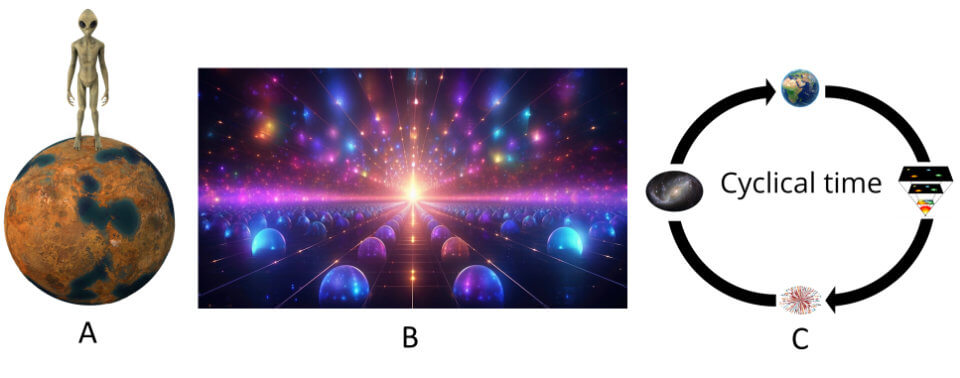
But you keep pressing and ask, “OK, but what kind of hosts did the mindstream possess before any sentient animals were roaming Earth?”. And that would be a very good question!
At this point, it is important to remember that in Buddhism life exists beyond our planet. Mindstreams that populated beings from other planets could potentially be transferred to earthlings (figure A above).
Even the Big Bang is not a hurdle. Buddhists believe that our universe is simply one of many generations of universes that regress to infinity (figure B above). One could even bring up the Eternal Recurrence idea I mention below, and argue that our existence is itself cyclical (figure C above).

And, remember, there are also other realms beyond the reality we know of. There’s the hell, demi-god and god realms, places we cannot directly access with our limited senses, but in which our mindstreams can also linger.
The take-home message is that you shouldn’t view the mindstream as something especially human or “made” for humans. A mindstream, as I understand it, is immaterial and thus independent of the type of body it inhabits. It simply contains the actions (karma) that will determine the type of life you will have next.
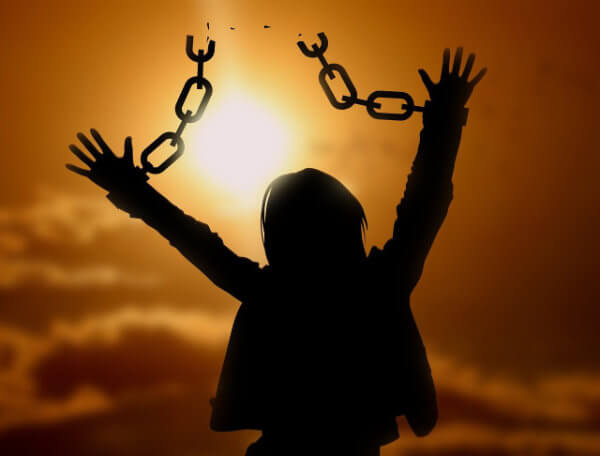
The cyclical process of birth and rebirth is termed samsara, and in Buddhism, it’s an annoyance because there can never be true peace and freeing of the mind.
For that reason, the Buddhists believe that it should be everyone’s goal to free ourselves from the samsara to end this cycle of suffering.
You might disagree. Why would the end of samsara be a good thing? Your life is great, you haven’t done much wrong in the world, so let’s keep the samsara going, shall we?
However, this is the kind of thinking Buddhists believe is flawed and delusional.

First of all, you cannot control what kind of rebirth you will have next life. It’s true that good actions encourage happier rebirths, but, remember, every action counts. We aren’t perfect, and surely there is a dark side of us that will eventually come back and bite us on the arse.
Second, even if you are reborn into a happy life, there is always a risk you’ll become greedy, selfish, and corrupt. If so, your next life could be one of misery and pain.
Third, even though living as a human is considered to have been a happy rebirth (i.e., a higher realm), even happy moments have a precarious existence. Impermenance – that is, the idea that evertything is changing and that nothing is permanent – is a feature in our lives. We will all eventually be confronted with disappointments, heartbreaks, illnesses and death.
Finally, don’t you feel that even when you have something good going on with your life, you are always craving for more. What we have is never good enough. We constantly seek more wealth, reputation, love… The lack of fulfillment everyone experiences in their lives is exactly why Buddhists believe it is important to break the cycle.
The question is… how?
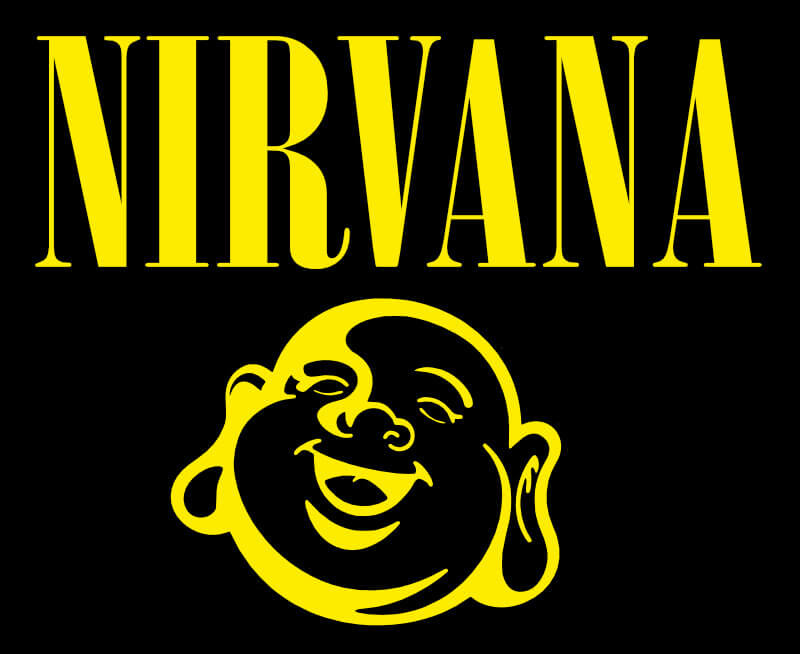
There can only be one way to end the cycle of death and rebirth, and that is if we attain nirvana.
Nirvana (aka, enlightenment or awakening) is simply the idea that we have achieved total peace and tranquility of mind – we have become Buddhas (by the way, in Sanskrit, Buddhá, बुद्ध, simply means “awake” or “enlightened”). When nirvana is attained there’s no more rebirth, no more suffering.
We need to appreciate that nothing is permanent, not even our identity, so there is little point becoming too attached to material possessions or even to people.
To realise nirvana is, thus, to understand that we are all, to some extent, motivated by greed, hatred and delusion. We need to destruct these “poisons” and cultivate positive attitudes such as generosity, compassion, equanimity and wisdom.
Most of the work entails introspection, that is, examining whether our actions and thoughts could potentially be harmful to us or to others. By carefully following a set of guidelines known as the eightfold path (see figure above), as well as promoting ethical behaviour, we should be on a good way towards Nirvana.
Once we achieve Nirvana the endless cycle of rebirth and death is terminated.
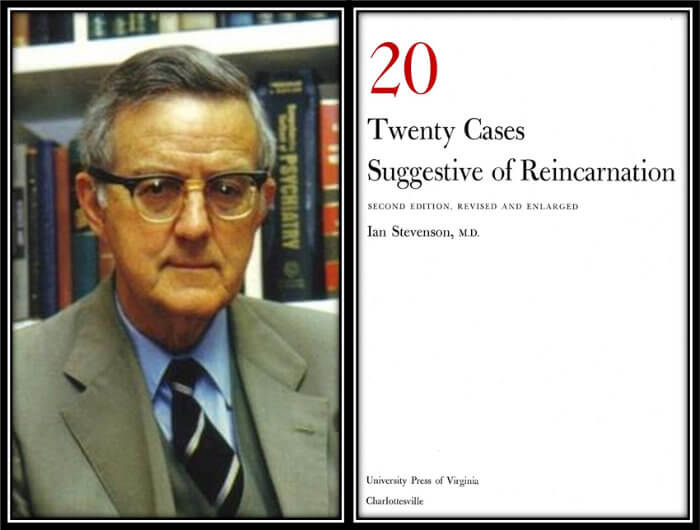
University of Virginia’s late Professor Ian Stevenson devoted most of his career researching reincarnation. Even though his first book on the subject – “Twenty Cases Suggestive of Reincarnation” – was received with skepticism from most of the scientific community, it remains the first true attempt at empirically investigating reincarnation.
Stevenson’s methods relied mostly on interviews with the alleged incarnates (i.e. the people claiming to be a reincarnation of a deceased individual) and/or first-hand witnesses, as well as studying any written documents available about the case. As soon as Stevenson got informed of a potential case, he (or some collaborator) would travel to the place where the reincarnated personality lived and conduct the interviews himself.
In most cases, Stevenson would only hear about the case several years after the initial reincarnation claim had been made. However, in some specific cases (e.g., Imad Elwaar), Stevenson managed to arrive at the location before anyone had tried to verify the memories of the alleged incarnate. Presumably, this avoided potentially influencing the child with information he/she could have heard from other people, and allowed Stevenson to directly observe the meeting between the family of the deceased individual and the allegedly reincarnated personality.
Stevenson would meticulously interview and record the memories of the child and first-hand witnesses. Next, he would also interview and record the memories of the family of the past life. Finally, he would check both the congruencies and incongruencies in the reports, in order to make a final verdict whether the case was suggestive of reincarnation.
One aspect that was crucial in deciding the merit of the reincarnation claim was the presence of birthmarks in some of the alleged incarnates.

According to Stevenson, one of the most convincing evidence of past lives comes from birthmarks and birth defects on the alleged incarnates.
For most of the cases, Stevenson either could not verify the wounds of the alleged past lives, or had to rely on the informants’ memories of potential wounds on the deceased individuals. However, in a small number of cases, Stevenson accessed the actual medical records of the deceased individuals, and, thus, could compare the wounds with the birthmarks of the alleged reincarnated personalities.
For example, Metin Köybaşi claimed to be the reincarnation of a relative who had died from a bullet wound to the head. The bullet had entered the left side of the head and stopped close to the right side of the neck. The pathologist then extracted the bullet via a small incision on the neck. Metin, the alleged incarnate, had been born with areas of increased pigmentation on either side of his neck, around the same areas as the wound of entry and incision performed by the pathologist.
In another case, Tali Sowaid had memories of a man that was shot close range, with the bullet entering one side of the face and exiting on the other. Stevenson noticed two birthmarks on each side of Tali’s cheeks. Stevenson was also aware that entry bullet wounds are usually smaller and rounder than exit bullet wounds, and the birthmarks of Tali seemed to correspond to that fact.
Walter Wilson accidentally shot a shotgun bullet, which came through his left hand and exited his wrist. The man died after surgery at the hospital. Alan Gamble, a near relative of Walter Wilson, was born with two birthmarks on his left hand and wrist.
In yet another case, Sunita Singh had been born with a large birthmark of the port-wine stain type which extended from upper right chest to the right arm, and additional birthmarks on the neck and chest. Later she claimed to be the reincarnation of a woman called Ram Dulari, who had been killed by a sword. The postmortem report of Ram Dulari showed that the wounds on her neck and chest corresponded closely to the location of Sunita’s birthmarks. Because Ram Dulari had not been washed before the cremation, Stevenson speculated that the port-wine stain birthmarks corresponded to the blood left on Ram Dulari’s body.
Nasruddin Shah claimed to have memories of a man Hardev Baksh Singh who, during a quarrel over cattle, was killed with a spear through his left upper chest. The postmortem report indicated that the spear wound in Harvev was located near Nasruddin’s left chest birthmark.
Narong Yensiri spoke of his grandfather, who died under mysterious circumstances. Upon examination of the medical report, Stevenson noticed several wounds on the deacesed body in places corresponding to the locations of several birthmarks in Narong’s body.
Necip Ünlütaşkiran claimed to be the reincarnation of a man called Necip Budak, who got stabbed repeatedly in the chest after a quarrel. Many of Necip Ünlütaşkiran’s birthmarks matched the stab wounds on Necip Budak’s body.
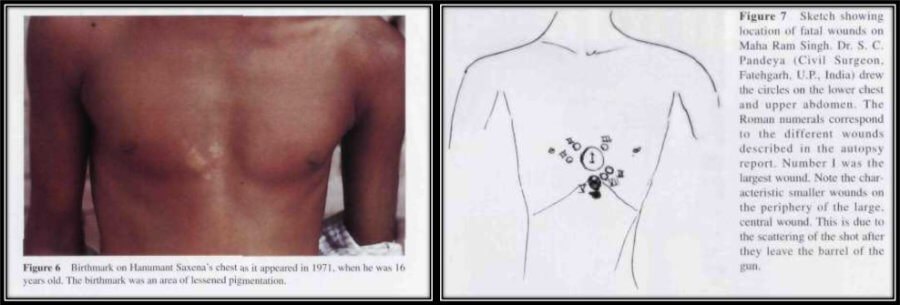
Hanumant Saxena had memories of a man Maha Ram, who was fatally shot at close range with a shotgun. The doctor that examined the body of Maha showed Stevenson his own sketches of Maha’s wounds (right figure above), and the correspondence between the location of the wounds and Hanumant’s birthmarks (left figure above) was very high.
Sunita Khandelwal was born in Laxmangarh, India, with a large birthmark on the right side of her head. She claimed to be the reincarnation of an unnamed 8-year old girl living in Kota, a city 350 km away from Laxmangarh. She mentioned that her cousin in the previous life had pushed her down. When she and her parents visited Kota, they got to know a man who had an eight-year-old daughter, who died of a head wound after her cousin accidentally pushed her down a balcony. Stevenson looked at the medical records who identified the cause of death as likely from a fracture of the base of the skull, causing hemorrhage and swelling of the brain.
Why are most memories always about gruesome deaths like point-blank shots and trauma? Stevenson speculated that the reason is that these deaths are so violent that they are retained memory for whoever reincarnates.

Here’s what Nietzsche had to say about the idea of Eternal Recurrence:
“What, if some day or night a demon were to steal after you into your loneliest loneliness and say to you: “This life as you now live it and have lived it, you will have to live once more and innumerable times more; and there will be nothing new in it, but every pain and every joy and every thought and sigh and everything unutterably small or great in your life will have to return to you, all in the same succession and sequence – even this spider and this moonlight between the trees, and even this moment and I myself. The eternal hourglass of existence is turned upside down again and again, and you with it, speck of dust!”
So, according to Nietzsche, every moment that makes up our lives will be re-experienced again in exactly the same way.
That means that every pleasure you’ve had, every pain, every thought, every laugh, absolutely everything, will be replayed an infinite number of times, and in the exact same order as you have previously experienced them.
Now, why did Nietzsche come up with such an outlandish idea?

The doctrine of the Eternal Recurrence is mentioned in Nietzsche’s book The Gay Science. In this book, Nietzsche tells us to imagine standing in the middle of a road. Behind us, the road goes on and on indefinitely – this road represents the past. In front of us, the road is equally infinite in length – that would be the future. The exact spot we are standing on, that is the present.
It follows then that if the path behind us is infinite, then everything that can happen will have happened. The past contains everything, and there is nothing new that could have happened.
The same logic applies to the road to the future. It’s infinite, so it will contain every possibility.
Nietzsche’s reasoning was that the past already contains all my experiences and moments, and the future, being infinite, will also contain the same experiences and moments.
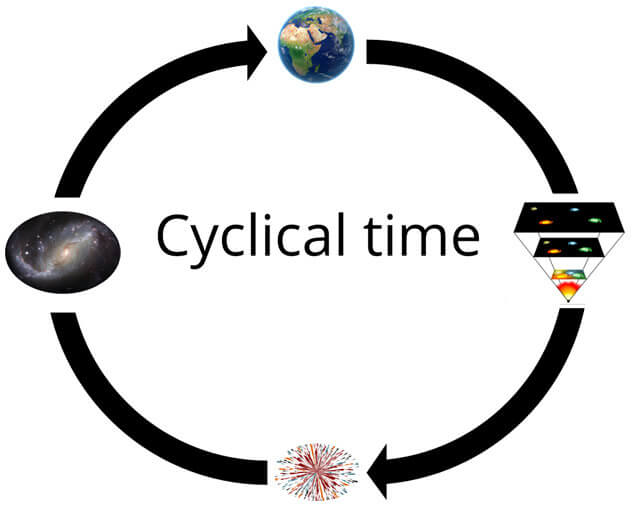
Nietzsche continues with his thought experiment, saying that we should visualise time as circular. We shouldn’t fall prey of our perception of time being linear, with a beginning and an end.
Furthermore, Nietzsche argues that the universe, and everything it contains, is nothing more than finite energy. We are manifestations of that energy, and so are all animals, the sea, atoms, galaxies, and everything else. Because the energy within the universe is finite, there is a finite number of rearrangements of that energy. In other words, the totality of beings and events that can possibly happen in our universe is limited.
In contrast, time is infinite. And if you have a limited amount of events but infinite time to express those events, then, at some point, you will have to repeat those same events (by the way, this idea is similar, but not quite the same, as the scientific theory of an infinite universe).
Thus, everything is considered eternal, not because they are immortal, but because they live and die an infinite amount of times.

Cloud Atlas tells the story of six characters, Ewing in the 19th century, Frobisher in the 1930’s, Rey in the 1970s, Cavendish in the early 21st century, Sonmi~451 in the far future, and Zachry (and Meronym) in an even farther future.
Let’s begin explaining Cloud Atlas by starting with the element that gave the novel its name.
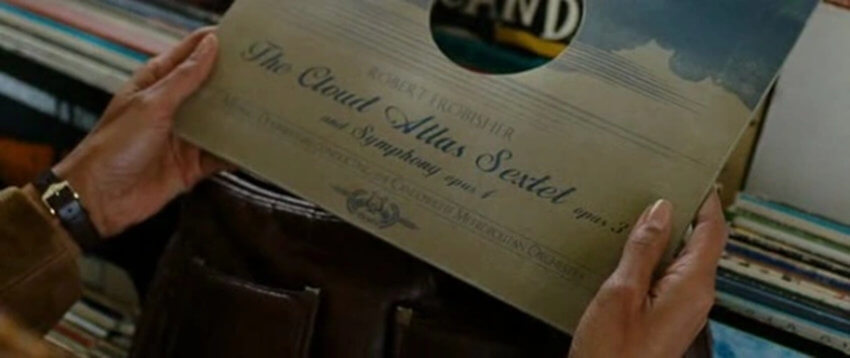
Cloud Atlas Sextet was the name of Frobisher’s six-movement composition. The Sextet can also refer to six musicians, perhaps a reference to the six central characters in the novel. Indeed, Frobisher describes his composition as “sextet for overlapping soloists“, including a pianist, a cellist, a violinist, an oboist, a clarinetist and a flutist, “each in its own language of key, scale and colour“.
He then mentions that, “In the 1st set, each solo is interrupted by its successor: in the 2nd, each interruption is recontinued“.
Does this sound familiar to you? It should, because Frobisher is describing the organisation of the book!
The six soloists represent the the six main characters of the different stories. Each character has also its own “language”, that is to say they come from different worlds and timelines.
Also, each character is interrupted by its successor, which is to say their stories are interrupted by the next story, and, in the second part of the book, the stories are resumed.
Just before Frobisher’s suicide he writes to his friend Sixsmith: “Cloud Atlas Sextet holds my life, is my life“.
Based on these clues, I believe the composition Cloud Atlas is meant to symbolise the characters’ soul, or the mindstream in Buddhism. By choosing the medium of music, Frobisher has created something immaterial and ethereal which can be passed on across generations.

During the interview for BBC4, Mitchell mentioned that all characters other than one are reincarnations, who share a birthmark in form of a comet.
Reincarnation, or rebirth, is one of the central tenets in Buddhism (see section Rebirth according to Buddhism). Even though it isn’t clear which religion Mitchell based his novel on, it is interesting that Sonmi, who becomes venerated by the Valleysmen in “Sloosha’s Crossin’ an’ Evrythin’ After”, comes from Korea, a country where Buddhism has a strong presence.
Furthermore, at some point in the novel, Sonmi meets the abbess of the Mountains, who tells her that Siddarhta Gautama’s teachings centred on how to overcome pain and achieve a higher reincarnation in future lifetimes. Sonmi then expressed her wish to be reincarnated in the Abbess’ colony.
Well, Siddarthta would become the Buddha around the 5th century B.C.E., and his teachings the foundation of Buddhism.
Thus, it is possible that the reincarnation theme in Cloud Atlas is strongly influenced by Buddhist traditions, as I will mention below.

One line of research on reincarnation I described above was based on the idea that certain types of birthmark on children that claim to be reincarnations, often correspond to fatal wounds on the bodies of the alleged past life.
According to Ian Stevenson, a birthmark on the body of the child was the result of an imprint on the child’s embryo/fetus with “memories” of the wounds of the deceased individual.
In Cloud Atlas, the comet birthmark seems identical in some of the characters, suggesting a similar mechanism. However, nowhere in the book does Mitchell explain the meaning of the comet birthmark. Why a comet? Why between the shoulder blade and collar-bone?
Comets are cosmic objects made of a combination of gas, dust and rock which orbit the sun at regular intervals.
Thus, one could speculate that there is a parallel with the Eternal Recurrence idea. The comet, just as life itself, always returns to complete the cycle, just as the organisation of the book implies that time is circular and the events repeat over and over again.
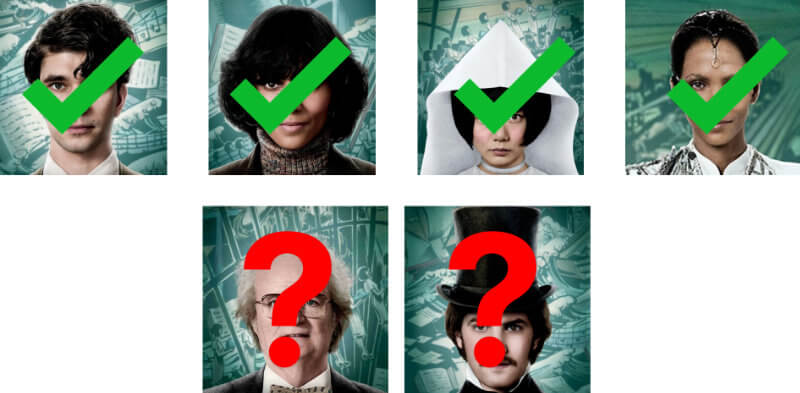
If the comet birthmark can be used to identify the incarnates then we have:
Robert Frobisher: “She plays with that birthmark in the hollow of my shoulder, the one you said resembles a comet“.
Luisa Rey: “Luisa shunts these aside to get a clearer view of a birthmark between her shoulder-blade and collar-bone. […] it is undeniably shaped like a comet.“
Timothy Cavendish: “I, too, have a birthmark, below my left armpit, but no lover ever compared it to a comet.“
Sonmi~451: ““My birthmark always caused me embarrassement when xposed.” […] “It resembles a comet.”“
Meronym: “Lady Moon lit a whoahsome wyrd birthmark jus’ b’low my friend’s shoulder blade as she [Meronym] sleeped fin’ly. A sort o’ tiny hand-mark it were, yay, a head o’ six streaks strandin’ off […]“.
There three observations we need to make here:
1) The book does not explicitly say who has the birthmark in Ewing’s story. It is unclear whether Ewing, Dr. Goose, Autum or any other character possess any birthmark whatsoever.
2) In “Sloosha’s Crossin’ an’ Evrythin’ After”, it is Meronym the one with the birthmark in the shape of a comet. At the end of the chapter, Zachry’s son ends with this: “he [Zachry] even b’liefed Meronym the Prescient was his presh b’loved Sonmi, yay, he ’sisted it, he said he knowed it all by birthmarks an’ comets’n’all.“.
3) Cavendish does have a birthmark, but it is possible that it is not in the shape of a comet.
Based on these observations, we can say with confidence that only Frobisher, Rey, Sonmi~451 and Meronym are reincarnations of one another (if the birthmark is the glueing piece).
So where does that leave the other main characters: Ewing, Cavendish and Zachry?
In my view, one of these characters is the odd-one-out mentioned by Mitchell in his interview for BBC4.
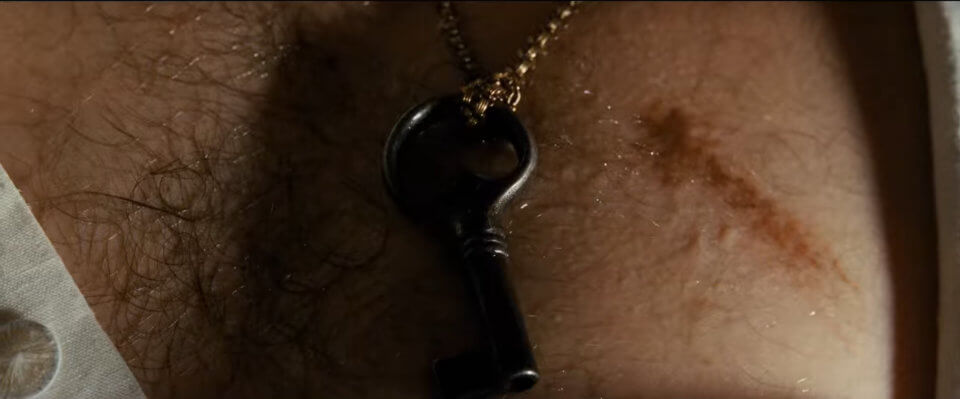
Let’s start with Ewing.
Nowhere in the book it is mentioned that Ewing (or any of the supporting characters) has a birthmark, let alone a comet-shaped one. It would be easiest, perhaps, to suggest that Ewing is the outsider, and it was really Frobisher who set off the series of reincarnations.
However, I don’t believe that makes much sense. First, Rey is deeply connected to Ewing. When she passes by the restored The Prophetess (the ship which brought Ewing from Hawaii to California), Rey feels a deep and mysterious connection with it: “Luisa is distracted by a strange gravity that makes her pause for a moment and look at its rigging, listen to its wooden bones creaking. […] Luisa’s birthmark throbs. She grabs for the ends of this elastic moment, but they disappear into the past and the future.“
What this seems to suggest is that Rey and Ewing are connected somehow. What’s more, the comet-shaped birthmark is at the center of it all. So, even though it is unclear if Ewing possesses a birthmark, he most likely does.
Now, Cavendish – this is a really tough one, so we need to dedicate an entirely new section to him…

Before we discuss Cavendish, one thing some readers may have missed is that the lifetime of Rey and Cavendish overlap (see figure below).
Rey is 26 years old living in 1975, whereas it is not revealed in which year Cavendish’s story takes place. BUT, when Cavendish tried to make an escape from Aurora House, he mentions that “I haven’t run since the mid-seventies.“
Well, if he ran in the mid-seventies, he ran when Luisa Rey was alive and doing her research on HYDRA.
Alas, we hit a conundrum.
Both Rey and Cavendish have a birthmark, which, at face value, suggests they are reincarnations of one another. However, how can they be both reincarnations if they are both alive at the same time and of similar age?

There are (at least) two possibilities.
Some readers have noted the ghastly way Frobisher ended his life, and suggested that, perhaps, after his death, Frobisher’s soul was split into two halves. Thus, it could be that Cavendish and Rey are sharing a soul, torn in two after Frobisher’s death. It is a radical idea, but one which would reconcile the fact that Cavendish and Rey are living at the same time.
To be honest, I do not see much merit in this interpretation. If that were true, then Rey and Cavendish are about the same age. Why doesn’t Cavendish appear in Rey’s story? Why doesn’t Rey connect to Cavendish?
The other possibility, and the one I lean more towards, is that Timothy Cavendish is not a reincarnation! Therefore, he is the odd-man-out that Mitchell referred to in his BBC4 interview.
Note that Cavendish does have a birthmark, but he says it looks nothing like a comet.
At first, I dismissed Cavendish’s comment as a mere disparaging remark of a grumpy fellow who is too willing to criticise everything around him. But, of all his lovers, no-one had the impression that his birthmark looked like a comet, when everyone else seems to think so? Apparently, one of them even said it looks like Timbo’s turd (!).
So, perhaps the birthmark is really not identical to the others. In fact, its position is in a different location than Frobisher’s, Rey’s and Sonmi’s birthmarks, all of which are located between the shoulder-blade and the collar-bone (Cavendish’s is below the left armpit).
Furthermore, Cavendish doesn’t appear to “feel” the other supposed incarnates; he doesn’t have déjà vus or visions of past lives like the other characters.
As a matter of fact, Cavendish seems almost detached from the entire novel, as if he is an outside. Check this comment: “One or two things will have to go: the insinuation that Luisa Rey is this Robert Frobisher chap reincarnated, for example“.
Just as Zachry is narrating his story, so is Cavendish the narrator of his own story. Since Zachry is unlikely to be a reincarnation, if I were to ditch Cavendish or Rey as being a reincarnation, I would choose Cavendish.
However, many readers are more willing to believe Luisa Rey isn’t a reincarnation. And the reason is that she might not even be a real person within the Cloud Atlas universe.
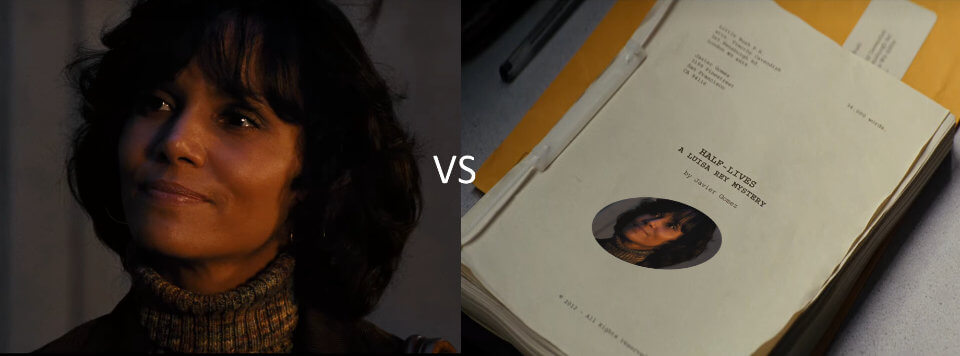
There is a lot of good debates out there (e.g., reddit, goodreads) about whether Luisa Rey is an actual person in the book or a fictional character.
What evidence is there for the fictional nature of Rey’s character?
1) The title of her story is literally: “Half-Lives: The First Luisa Rey Mystery”. It does sound pretty much like the title of a series of detective stories.
2) Timothy Cavendish comes across a book entitled “Half-Lives: The First Luisa Rey Mystery” by a certain Hilary V. Hush, and treats it as a work of fiction, strongly suggesting that Luisa Rey is a mere fictional character within the Cloud Atlas universe.
3) “Half-Lives: The First Luisa Rey Mystery” describes made-up Californian places such as Buenas Yerbas (although there is a place called Yerba Buena Island in San Francisco) or Swannecke river .
I have to admit though that I’m leaning more towards the idea that Rey is not supposed to be a fictional character.
Let’s start with point (3) above. Even though Buenas Yerbas does not exist in actuality, it is nevertheless mentioned in “Sloosha’s Crossin’ an’ Evrythin’ After”: “My parents an’ their gen-’ration b’lieved, somewhere, hole cities o’ Old’uns s’vived the Fall b’yonder the oceans, jus’ like you, Zachry. Oldtime names haunted their ‘maginin’s… Melbun, Orkland, Jo’berg, Buenas Yerbas […]“.
Likewise, Swannecke is also mentioned in that same story: “She [Meronym] ’fessed most Prescients cudn’t ride no animal but she’d lived with a tribe called the Swannekke what lived way past Ank’ridge an’ way past Far Couver“.
So, I believe we can confidently discard (3) as evidence for her fictitious nature.
Now, number (1) and (2) are trickier, but let’s see the counter-arguments.
1) Luisa Rey interacts with Sixsmith, who appears to exist in Frobisher’s story. So, if Rey is fictitious, so must be Frobisher, and, by extension, Ewing.
2) Luisa Rey is also a character in Mitchell’s other books, in which she exists as a real person in the same universe as Cloud Atlas.
3) In Cavendish’s story, the name of the author of “Half-Lives: The First Luisa Rey Mystery” is a certain Hilary Vincent Hush. The identity of this person is never revealed to us, but many readers have speculated the name is most likely a pseudonym, perhaps of Rey herself.
In the film, just when Timothy Cavendish is putting down Rey’s manuscript, we can see the author’s name “Javier Gomez”, Rey’s teenager friend (in the book, he is called Javier Moses), who is fascinated with crime novels – perhaps, he is the incognito author of the books.
4) Rey’s mother lives in Ewingsville, which is likely a city founded in honour of Adam Ewing, who likely lived there after returning from Hawaii.
In fact, Rey has a paranormal experience when she passes by the ship on which Ewing ostensibly sailed from Hawaii to California. Her birthmark even begins to throb.
5) But the most convincing clue that Luisa is just as real as any other character comes from Sonmi~451. Check what she says: “Mr. Chang warned us to brace, killed the engine and swerved off the road. […] The ford gathered speed, weight, weightlessness. I remember the drop: it shook free an earlier memory of blackness, inertia, gravity, of being trapped in another ford; I could not find its source in my own memories.”
I dont know about you, but that looks a lot like Rey’s accident on the Swannecke bridge. If so, then Sonmi is having a déjà vu, the likes of Frobisher’s and Rey’s.
These points suggest that Rey is likely a reincarnation of Ewing.

There is another major theme in Cloud Atlas, which is not as obvious as reincarnation, and that is the idea of Eternal Recurrence. As explained in the section Eternal Recurrence: Nietzsche’s most-abysmal thought, Eternal Recurrence sees time as circular and that everything eventually repeats itself.
Setting aside direct references to this philosophical concept (e.g., Ayrs mentioning that his last symphonic work will be titled Eternal Recurrence, based on Nietzsche’s philosophy), there are some subtle clues throughout the novel that suggest that some past characters appear to experience bouts of clairvoyance or other paranormal futuristic activity.
Here’s a few:
1) Ewing experiences severe headaches on the journey to Hawaii, which may presaging the murder of the clones in “The Orison of Sonmi~451” who, expecting a boat trip to Hawaii, are shot dead in the head.
2) Frobisher describes the urge to kill Ayrs in one of his letters: “A blue vein throbbed over Ayrs’s Adam’s apple and I fought off an uncountably strong urge to open it up with my penknife. Most uncanny. Not quite déjà vu, more jamais vu.” Jamais vu is the feeling that a person or event is unfamiliar even though that person or event is actually very familiar.
The experience Frobisher is referring to may be the event in which Zachry slits the throat of a Kona (even though Zachry is probably not a reincarnation of Frobisher).
“A vein pulsed in his Adam’s apple […] an’ I stroked my blade thru his throat. […] I’d stony my cussed soul. If I’d been rebirthed a Kona in this life he could be me an’ I’d be killin’ myself“.
3) In “The Ghastly Ordeal of Timothy Cavendish”, Nurse Noakes mentions that “Because you [Cavendish] are new I will not have you eat soap powder.”, which is probably a reference to the soap fabricants eat in “An Orison for Sonmi~451”.
Cavendish also mentions at some point: “Ursula and I went punting below that quaint bridge, where those Biotech Space Age cuboids now sit cloning humans for shady Koreans“, which is a direct reference to Sonmi~451 and her fellow clones.
4) At some point in “An Orison for Sonmi~451”, Hae-Joo is supposed to complete a code to grant him passage, and the passphrase was “Travel far enough, you meet yourself“. I interpreted the “Travel far enough” as very Nietzschesque.
5) When Rey approaches the ship Ewing was on, Rey’s birthmark starts to throb, at which point Rey “grabs for the ends of this elastic moment, but they disappear into the past and the future”.
Disappearing into past and future suggests a never-ending and cyclical continuum. I should point out that it is unlikely Rey’s experience is the result of wishful thinking. She can’t have made the connection between The Prophetess and Ewing, because Frobisher doesn’t mention the ship in his letters.
6) Writing to Rufus Sixsmith, Frobisher opens his heart to his friend:
“Strip back the beliefs pasted on by governesses, schools and states, you find indelible truths at one’s core. Rome’ll decline and fall again, Cortazar’ll sail again and, later, Ewing too, Adrian’ll be blown to pieces again, you and I’ll sleep under Corsican stars again, I’ll come to Bruges again, fall in and out of love with Eva again, you’ll read this letter again, the Sun’ll grow cold again. Nietzsche’s gramophone record. When it ends, the Old One plays it again, for an eternity of eternities.”
And then he continues:
“We do not stay dead long. Once my Luger lets me go, my birth, next time around, will be upon me in a heartbeat. In thirteen years from now we’ll meet again at Gresham, ten years later I’ll be back in this same room, holding this same gun, composing this same letter, my resolution as perfect as my many-headed sextet. Such elegant certainties comfort me.“
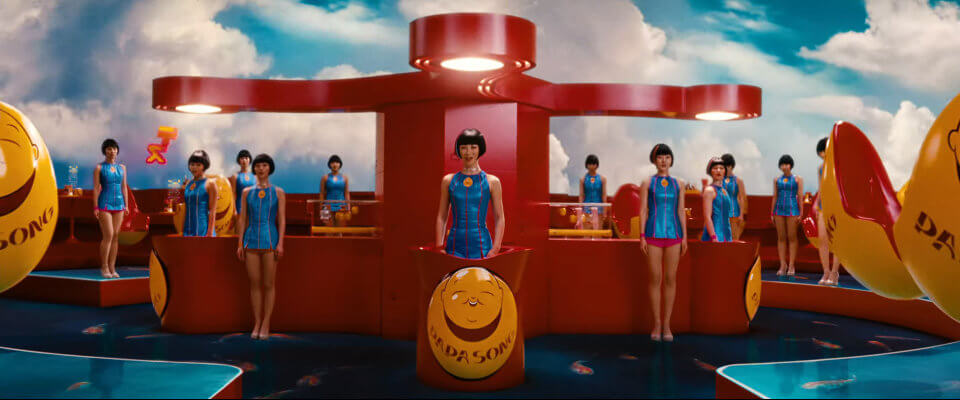
But perhaps the best evidence of eternal recurrence in the novel is Ayrs’ foreseeing of the Papa Song restaurant with all its clones eating soap. The melody he came up with came from the Papa Song melody from “An Orison for Sonmi~451”.
““I [Ayrs] dreamt of a … nightmarish café, brilliantly lit, but underground, with no way out. I’d been dead a long, long time. The waitresses all had the same face. The food was soap, the only drink was cups of lather. The music in the café was”—he wagged an exhausted finger at the MS—“this”“.
How can Ayrs possibly have known what will happen decades into the future in Korea?
The answer lies in that Ayrs, being likely a reincarnation himself (which I will not discuss in this article; see Could every character be a reincarnation?) has inherited memories from incarnates that do not yet exist in his timeline.
So the characters aren’t only connecting with the past, they are also connecting with the future as well. If past, present and future are connected, this must necessarily entail a cycle.

The organisation of the book is a final clue of this Eternal Recurrence idea. By making “Sloosha’s Crossin’ an’ Evrythin’ After” the central story from which everything else converges towards, it acts as a sort of a thread that unites all other stories. By starting with Ewing and ending with Ewing, the book gives off the impression of a cycle – if it ends with Ewing, it must continue with Frobisher, Rey, and so on.
There is another point in “Sloosha’s Crossin’ an’ Evrythin’ After” that informs us a great deal about Eternal Recurrence. Judging by the primitive society and crude technology used by Zachry’s village, humanity appears to have regressed many centuries into the past. The most advanced civilisation, the Prescients, are in steep decline, as plagues run rampant all over the world, killing much of the technologically-advanced people.
What is the logical conclusion of all this?
Well, in my view, it tells us that we are returning to our modest beginnings, when humans were living in hunter-gather cultures about 12,000 years ago. Obviously, a time which would have way preceded Sonmi’s, Cavendish’s, Rey’s, Frobisher’s and Ewing’s lifetime.
The fact that Meronym’s mission failed implies that technological advances halted and civilization regressed to their nomadic begginings. With sufficient generations, humanity would forget all about its most glorious past, perhaps even destroying any remnants of Meronym’s, Zachry’s and everyone else’s existence.
Meronym would die and reincarnate into someone else, and that someone else would reincarnate into someone else, until the soul reached Ewing; the cycle would begin again.
Just as I explained in the section Mindstream, ad infinitum, the idea of Eternal Recurrence is not at odds with Buddhist thinking that the universe is cyclical and mindstreams ride along this eternal voyage through time and space.

OK, so I discussed Cloud Atlas in terms of reincarnation and Eternal Recurrence. But what is it Cloud Atlas all about? What is the big picture so to speak?
In my opinion, Cloud Atlas is about surpassing oneself, to better oneself, to pursue some ideal worth pursuing (which is very much in line with Nietzsche’s idea of will to power that I discussed in the article on Dogville).
Note how each character is learning with the occasion and events that happened during their lifetime. Each is becoming a more virtuous, more compassionate and/or more sensible person as the story progresses.
This idea of learning to become a better individual is related to the Buddhist concepts of karma and nirvana that I discussed above.
And I think it is interesting that Mitchell didn’t create a linear progression in which we witness a gradual change from a corrupt person at the beginning to an enlightened individual at the end.
No.
In all stories, every character goes through a personal transformation that not only makes them better individuals, but, in some cases, also leaves an indelible mark on the society.

Ewing started off being a racist and white supremacist, but ended up saving Autua’s life, befriending him, and, later, dedicating his life to the abolition of slavery.
Frobisher was a young man with a penchant for luxury which he could not afford. However, the character gradually learns to value more emotional well-being and love. He produces the sublime Cloud Atlas sextet, which moves the lives of subsquent reincarnations. Still, of all characters, Frobisher is the one with the least constructive development, which could be an argument for the soul-splitting hypothesis (i.e., Frobisher’s death splitting his soul into two, inhabiting both Cavendish and Rey).
Rey hungers for recognition and reputation. She puts herself at great peril by trying to unmask a corporate conspiracy surrounding a local nuclear power plant. However, thanks to her tenacity, she publicly exposes the corruption at the corporation, saving countless lives from what could have been a terrible nuclear catastrophe.
Cavendish’s contribution to humanity is smaller in comparison, and his story appears to only serve as inspiration for Sonmi’s ascension. Nevertheless, even Cavendish showed progress. Having lived a selfish, greedy and immoral life, his experiences at the Aurora House changed him to be a more compassionate and friendly man, building genuine connections with people rather than using them.
Sonmi is perhaps the character that had the greatest impact on the world. As a fabricant with limited experience and knowledge of the way of life, she eventually becomes a venerated figure by actively seeking to bring down the government and free fabricants from oppression.
Meronym’s and Zachry’s challenge are also more on a personal level. The unlikely intimate relationship Meronym develops with Zachry symbolises the power of friendship. Zachry’s successful containment of his demon suggests equanimity and tranquility of mind.
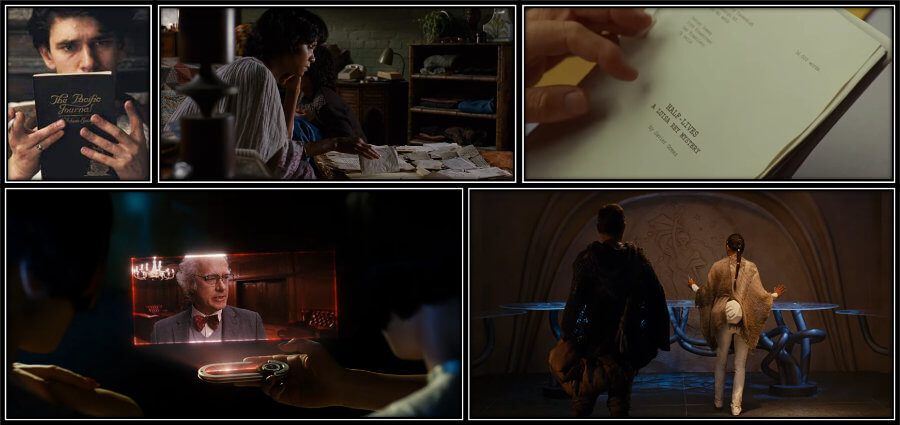
The key to each character’s transformation is the connection to the character from the previous story: Frobisher’s key was Ewing’s journal; Rey’s key was Frobisher’s letters; Cavendish’s key was Rey’s novel; Sonmi~451’s key was Cavendish’s film; Zachry’s key was Sonmi’s Declarations.
In Ewing’s case, the motivation to become an abolitionist may not explicitly appear to have been triggered by any previous character, since Ewing’s story is the most further into the past.
However, it is likely that even Ewing’s decisions may have been shaped by events occurring in the future, specifically from “Sloosha’s Crossin’ an’ Evrythin’ After”.
For example:
– Most white Europeans and Americans that accompany Ewing seem to believe white people to be more civilised and capable of developing an advanced civilisation than non-white people. In “Sloosha’s Crossin’ an’ Evrythin’ After”, however, it is the “dark-skinned” Prescients that have become the most advanced civilisation, whereas white people have receded to almost stone age cultures.
– Ewing learns that the local Moriori banishes any individual that kills a member of their group. Interestingly, the exact same practice of non-violence is enforced in Zachry’s village: “murderin was forbidden by Valleysmen law, yay, if you stole another’s life no’un barter nothin’ with you nor see you nor nothin’cos your soul was so poisoned you may give ‘em a sickness“.
– Ewing also learns that the Moriori had been brutally attacked and conquered by the Maori, with many Moriori being killed or enslaved by them. Similarly, in Zachry’s timeline, the Valleysmen have been conquered by a rival tribe, the Kona, who, just as the Maori did to the Moriori, also killed and enslaved many of the Valleysmen.
I don’t think these relationships are coincidental. Mitchell is giving us a clue that even Ewing’s transformation may have been triggered by similar events occurring in the far future.
Meronym’s realisation of the injustice regarding how the Kona treated the Valleysmen, could have served as inspiration for Ewing’s awakening in helping Autua and become an abolitionist.
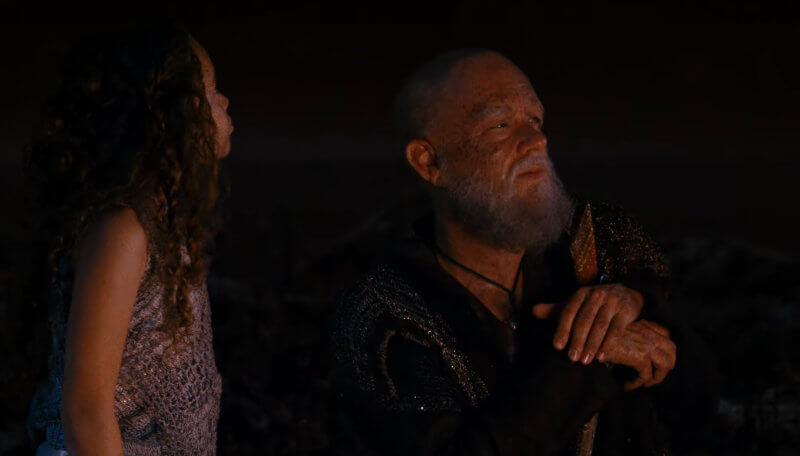
One reader once asked Mitchell a question of whether there was a particular character that Mitchell found pivotal to the book and that the book revolved around. Mitchell responded that that character was Zachry.
At face value, “Sloosha’s Crossin’ an’ Evrythin’ After” has the peculiarity that it is the only story which is being narrated by the main character itself, in this case, Zachry, who is telling his tale to his grandchildren.
So, the only character we know exists for sure is Zachry. We can doubt the existence of any other character, but not of Zachry. At the end of the chapter, one of Zachry’s children takes over the narration and confirms that Zachry was his/her dad. The child suspects that the stuff involving Meronym is almost certainly true, because he did find an orison device. However, the child is also convinced that some parts of Zachry’s story were likely embellished or made up.
I believe this is the reason why Zachry is such an important character. Everything hinges on Zachry telling the truth. If he is making Meronym up (or at least the part about her being a reincarnation), then we should seriously doubt the existence of the other characters. Zachry’s child only describes a “ghost-girl” appearing in the air and speaking a language nobody can decipher. No mention is made about how this girl looks like and what she did.
Here, Mitchell is playing with the idea of the unreliable narrator. I have analysed a few works in which the narrative relies on an unreliable narrator (e.g., check our articles on Christopher Nolan’s film “Memento”, Edgar Allan Poe’s novel “The narrative of Arthur Gordon Pym of Nantucket” or the painting “Not To Be Reproduced” by René Magritte).
However, if we believe Zachry’s story to be true, then Meronym is the reincarnation of Sonmi~541, who is the reincarnation of Rey (and Cavendish?), who is the reincarnation of Frobisher, who is the reincarnation of Ewing.

And that is interesting because “Sloosha’s Crossin’ an’ Evrythin’ After” is the only story that is not taking place inside another story. Ewing’s story is a based on journal entries edited by his son which is read by Frobisher. Frobisher’s story is told from letters supposedly written by Frobisher to his friend/lover Sixsmith, which are then read by Rey. Rey’s story is written as a fictional novel, which is read by Cavendish. Cavendish’s story is told as if it were a script for a movie and is, in fact, turned into a film, which is watched by Sonmi. Sonmi~451’s story is told as a series of recorded interviews, which are seen by Meronym and Zachry.
Take the first chapter (the first part of Ewing’s story) as an example. It kind of looks like it starts in the middle of Ewing’s adventure, and 40 pages later it ends abruptly mid-sentence.
Now, Frobisher mentions in one of his letters that the book about Ewing’s journey starts on page 99 and ends abruptly mid-sentence 40 pages later!
This may suggest that Ewing’s chapter is just how Frobisher is reading it!
The same could be said about any other character: maybe Frobisher’s chapter is how Rey is reading the letters; maybe Rey’s chapter is how Cavendish is reading the novel; maybe Cavendish is how Sonmi is watching the movie; maybe Sonmi is how Zachry is imagining her story.
If so, we can ask the question: is any of it real?
Only Zachry will know.
Cloud Atlas tells six different tales, happening at different time epochs.
By adding a mysterious birthmark and narrative nuances regarding reincarnation, Mitchell superbly connected these disparate stories in such a way that they all feel intricately interrelated.
There is a lot of food for thought. Ewing, Frobisher, Rey, Sonmi~451 and Meronym are, most likely, reincarnations of one another. It is unclear whether Cavendish is a reincarnation, or whether Mitchell included him on a whim, given the author’s fondness for the character.
Sharing traits of an unreliable narrator, everything hinges on the veracity of Zachry’s account of the events.
But what is Cloud Atlas really about?
Buddhism teaches us that this life is one of suffering, that we should accumulate good karma, practice self-instropection to break the infinite cycle of birth, death and rebirth and to achieve nirvana. In Cloud Atlas, we gradually see each character surprassing him/herself, becoming better individuals and making a mark in the world.
However, the cycle never seems to end.
The implication that time in Cloud Atlas is cyclical (the Eternal Recurrence idea), with past and future being connected, is suggestive that rebirth in the novel is eternal.
Is Mitchell saying something about human nature here? Is the message that humanity cannot achieve a global state of nirvana? That we are all doomed to commit the same mistakes over and over again?
That would surely be a pessimistic view on humanity, but, some would argue, a realistic one.
The idea behind Eternal Recurrence is surely disquieting. Even Nietzsche was terrified of his own thought when discussing it with his friend Lou Andreas-Salome. Zaratrustra called it the “most abysmal thought”.
And for good reason.
If time were indeed circular, as Nietzsche had envisioned it, that would mean every catastrophe that has befallen on humankind and every imaginable tragedy still to come would happen an infinite amount of times. Just imagine, having to relive the Plague, both world wars, 9/11, Covid, over and over again…
But don’t despair! The idea of Eternal Recurrence has been pretty much rebutted by contemporaneous science.
And that IS comforting.
See you in the next article!
Leave a comment
Add Your Recommendations
Popular Tags